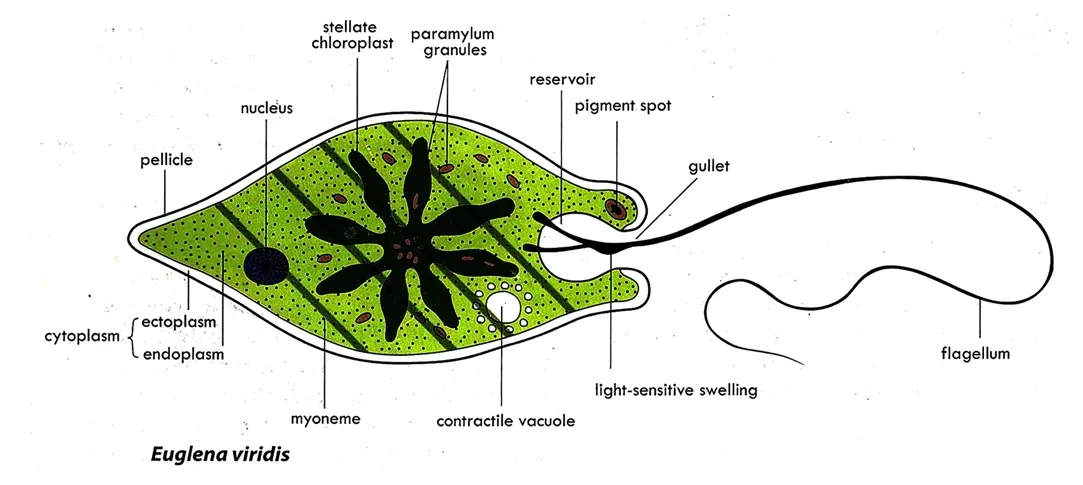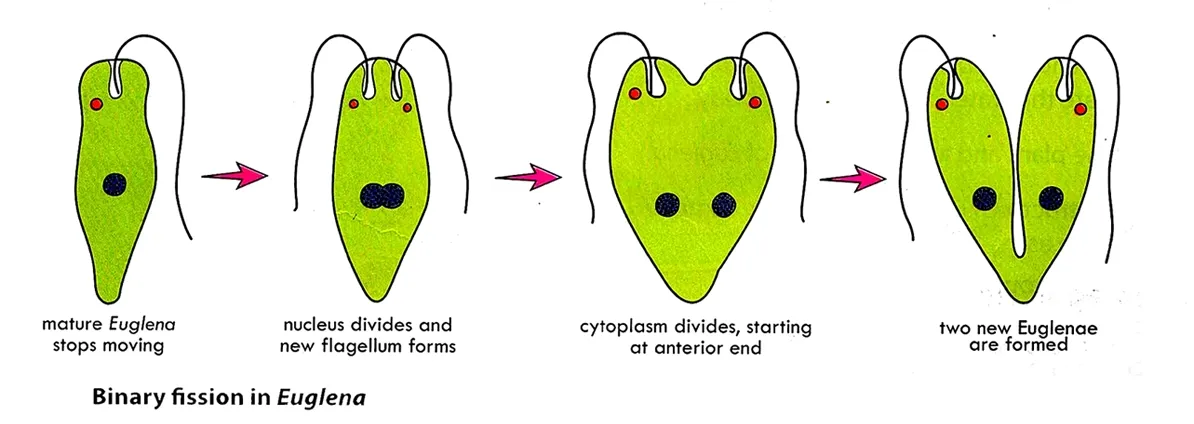Objectives
Euglena
Kingdom: Protoctista
Phylum: Euglenophyta
Habitat: lakes, ponds, ditches, contaminated stagnant water and slow-moving streams.
Structure of Euglena
Euglena is unique organism with both plant and animal features.
It is unicellular with a body covered with a thin, elastic and flexible pellicle, enclosing a cytoplasm.
The cytoplasm consists of thin outer clear ectoplasm (plasmagel) and an inner more fluid, granular endoplasm (plasmasol).
It has a gullet with reservoir base located at the anterior. A long flagellum and short one arising from the base of reservoir.
At the base of the long flagellum is photoreceptor covered by a red pigment spot called eyespot. This enables euglena to respond positively to light.
Within the cytoplasm lies a stellate chloroplast, eyespot at the anterior end, a contractile vacuole near the reservoir, paramylum granules and a nucleus placed towards the posterior end.
Life processes of Euglena
Movement in Euglena
Movement is achieved by lashing the long flagellum against the water. Waves in a spiral manner along the flagellum from the base to the tip causing Euglena to rotate about its anterior-posterior axis and also gyrate. Sometimes as Euglena moves along, the myonemes contract and relax alternatively causing waves to pass along the body from the anterior to the posterior end. It moves in a zigzag path whiles rotating on its axis, this wriggle movement is described as euglenoid.
Nutrition in Euglena
Autotroph: Euglena possesses chloroplast and feeds by means of photosynthesis. Energy trapped from the sun is used to synthesize glucose from water and carbon dioxide. Excess glucose is converted into starch and stored in the paramylum granules.
Heterotroph: Euglena without chloroplast ingests decaying plant and animal remains through the gullet and digest them in the reservoir.
Respiration in Euglena
Irritability in Euglena
Reproduction in Euglena
Euglena reproduces asexually by binary fission. It begins with division of the nucleus, followed by the longitudinal division of the cell itself.
In low moisture conditions, or when food is scarce, Euglena forms a protective wall around itself as in amoeba and lies dormant. The content of the cyst divides into two, four or more euglenae when favorable conditions return.
Plant-Like Features of Euglena
1. It has chloroplast containing chlorophyll used to absorb light.
2. Paramylum granules for starch storage
3. Pyrenoids
4. Definite shape
Animal-Like Features of Euglena
1. Gullet for feeding.
Adaptation
1. The body is protected by a stiff pellicle.
2. It has contractile for osmoregulation.
3. It possesses locomotory organ (flagellum) for movement.
4. Presence of chloroplast for photosynthesis
5. It has paramylum granules for starch storage.
6. It possesses eyespot for light sensitivity.
Click Here for WAEC/ SSCE/ WASSCE/ NOVDEC Past Questions and Answers










0 Comments